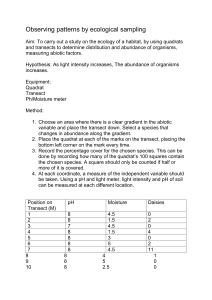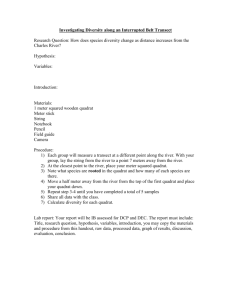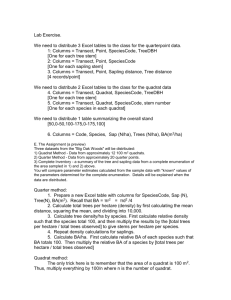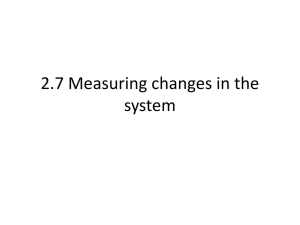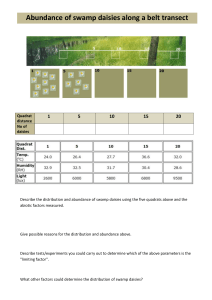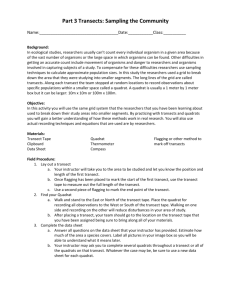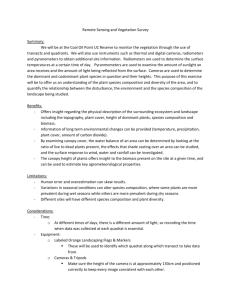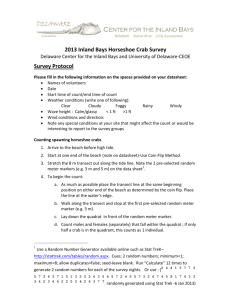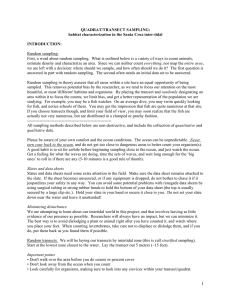Exercise 03
advertisement
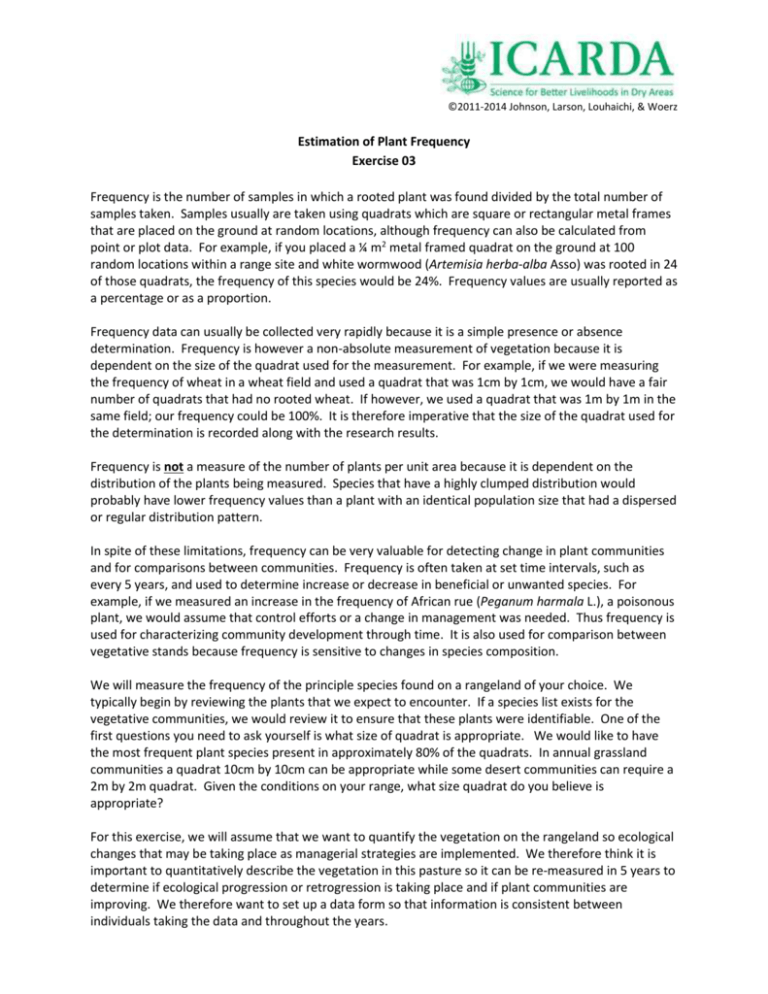
©2011-2014 Johnson, Larson, Louhaichi, & Woerz Estimation of Plant Frequency Exercise 03 Frequency is the number of samples in which a rooted plant was found divided by the total number of samples taken. Samples usually are taken using quadrats which are square or rectangular metal frames that are placed on the ground at random locations, although frequency can also be calculated from point or plot data. For example, if you placed a ¼ m2 metal framed quadrat on the ground at 100 random locations within a range site and white wormwood (Artemisia herba-alba Asso) was rooted in 24 of those quadrats, the frequency of this species would be 24%. Frequency values are usually reported as a percentage or as a proportion. Frequency data can usually be collected very rapidly because it is a simple presence or absence determination. Frequency is however a non-absolute measurement of vegetation because it is dependent on the size of the quadrat used for the measurement. For example, if we were measuring the frequency of wheat in a wheat field and used a quadrat that was 1cm by 1cm, we would have a fair number of quadrats that had no rooted wheat. If however, we used a quadrat that was 1m by 1m in the same field; our frequency could be 100%. It is therefore imperative that the size of the quadrat used for the determination is recorded along with the research results. Frequency is not a measure of the number of plants per unit area because it is dependent on the distribution of the plants being measured. Species that have a highly clumped distribution would probably have lower frequency values than a plant with an identical population size that had a dispersed or regular distribution pattern. In spite of these limitations, frequency can be very valuable for detecting change in plant communities and for comparisons between communities. Frequency is often taken at set time intervals, such as every 5 years, and used to determine increase or decrease in beneficial or unwanted species. For example, if we measured an increase in the frequency of African rue (Peganum harmala L.), a poisonous plant, we would assume that control efforts or a change in management was needed. Thus frequency is used for characterizing community development through time. It is also used for comparison between vegetative stands because frequency is sensitive to changes in species composition. We will measure the frequency of the principle species found on a rangeland of your choice. We typically begin by reviewing the plants that we expect to encounter. If a species list exists for the vegetative communities, we would review it to ensure that these plants were identifiable. One of the first questions you need to ask yourself is what size of quadrat is appropriate. We would like to have the most frequent plant species present in approximately 80% of the quadrats. In annual grassland communities a quadrat 10cm by 10cm can be appropriate while some desert communities can require a 2m by 2m quadrat. Given the conditions on your range, what size quadrat do you believe is appropriate? For this exercise, we will assume that we want to quantify the vegetation on the rangeland so ecological changes that may be taking place as managerial strategies are implemented. We therefore think it is important to quantitatively describe the vegetation in this pasture so it can be re-measured in 5 years to determine if ecological progression or retrogression is taking place and if plant communities are improving. We therefore want to set up a data form so that information is consistent between individuals taking the data and throughout the years. ©2011-2014 Johnson, Larson, Louhaichi, & Woerz Because we want to re-measure plots, we will establish permanent transect lines. Our initial quadrats will be placed on this transect line at random distances of 1 to 25m. In the years to come, samples will be taken at similar distances along the quadrat so that true change can be ascertained. We will determine the beginning and the end of our transects with a GPS and record them on our data sheets. We also want locations for each plot so people in the future can find not only our original transects but also quadrat locations. You will use a GPS or Smartphone to record the beginning and end of each transect line. Be sure to also record the Projection System and Datum used. We will also generate random numbers for distances between plots before we go to the field, so the distance along the line is known for each sample and sample positions can be plotted in a GIS. Thus plot information will be coded as a spatial database for use in a GIS. To generate random numbers, we can use either a random number table found on-line or in a statistics book or use a spreadsheet program such as Microsoft Excel. In Excel, random numbers are generated using the RAND function which returns an evenly distributed random real number greater than or equal to 0 and less than 1. Since we want a number between 1 and 25 we would type into a cell =RAND()*25 to receive a random number greater than or equal to 0 but less than 25. If we need 20 random numbers per transect, we would copy this formula into 20 cells. Because we don’t want to sample the same plot twice, we would ignore zero values. We should note that a new random real number is returned every time the worksheet is calculated. A sample data collection form that is set up for 15 quadrats per transect is provided. It will have to be modified for your site by changing the number of samples needed and the species expected to be encountered. We typically use plant symbols for the species to save space. Plant symbols consist of the first two letters of the genus name and first two letters of the species name and first letter of the infraspecific name. If several species have the same symbol, a numeric identifier is added. For plants identified only to the genus or family level, the first five (genus) or six (family) letters of the name are used. Plant symbols are useful in survey, monitoring, and inventory work because they reduce writing in the field. In the field, you should use a smartphone equipped with a compass app such as Smart Compass or Compass pro that provides direction and a Level/Inclinometer app (Bubble or Clinometer + slope finder + bubble level) to determine the slope and aspect of the land on which your transect line lies so we can categorize the site. Alternatively you can use an Abney Level or a Brunton-type compass for these variables. Slope should be reported as degrees and aspect, the compass direction the land faces, is also reported as degrees. Level land had no aspect and is reported as none. Record these values on your data sheet. Please answer or report the following: A) Provide the location of transect line and your plots along the transect line in Universal Transverse Mercator (UTM) Projection and WGS84 Datum. B) Prepare a frequency list that presents the mean frequency of each plant present along the entire transect line. C) Tell me if you think you progressed from one plant community to another as you moved along the transect line and if so, where. D) What was the maximum frequency measured? Was your quadrat size appropriate for this study? ©2011-2014 Johnson, Larson, Louhaichi, & Woerz Name _________________________________ Site ___________________________________ Date __________________________ Transect Start _________________ Lat.____________________ Long. ___________________ Transect End _________________ Lat.____________________ Long. ___________________ Slope ________________________ Aspect__________________ Project: _________________________________________________ Sample 1 Paces 14 Anar Arhe Brhod Brri Rubi Peha Plal POA Zilo 2 3 3 12 4 8 5 7 6 21 7 9 8 18 9 21 10 5 11 6 12 1 13 21 14 13 15 10 Notes: ______________________________________________________________________________
